Spotted lanternflies landed on my hat, my face and every other available surface of my body on August 5, at The Woodlands in West Philadelphia. I was there tagging along with a team of Penn State researchers on a mission to collect 3,000 of the bugs that morning.
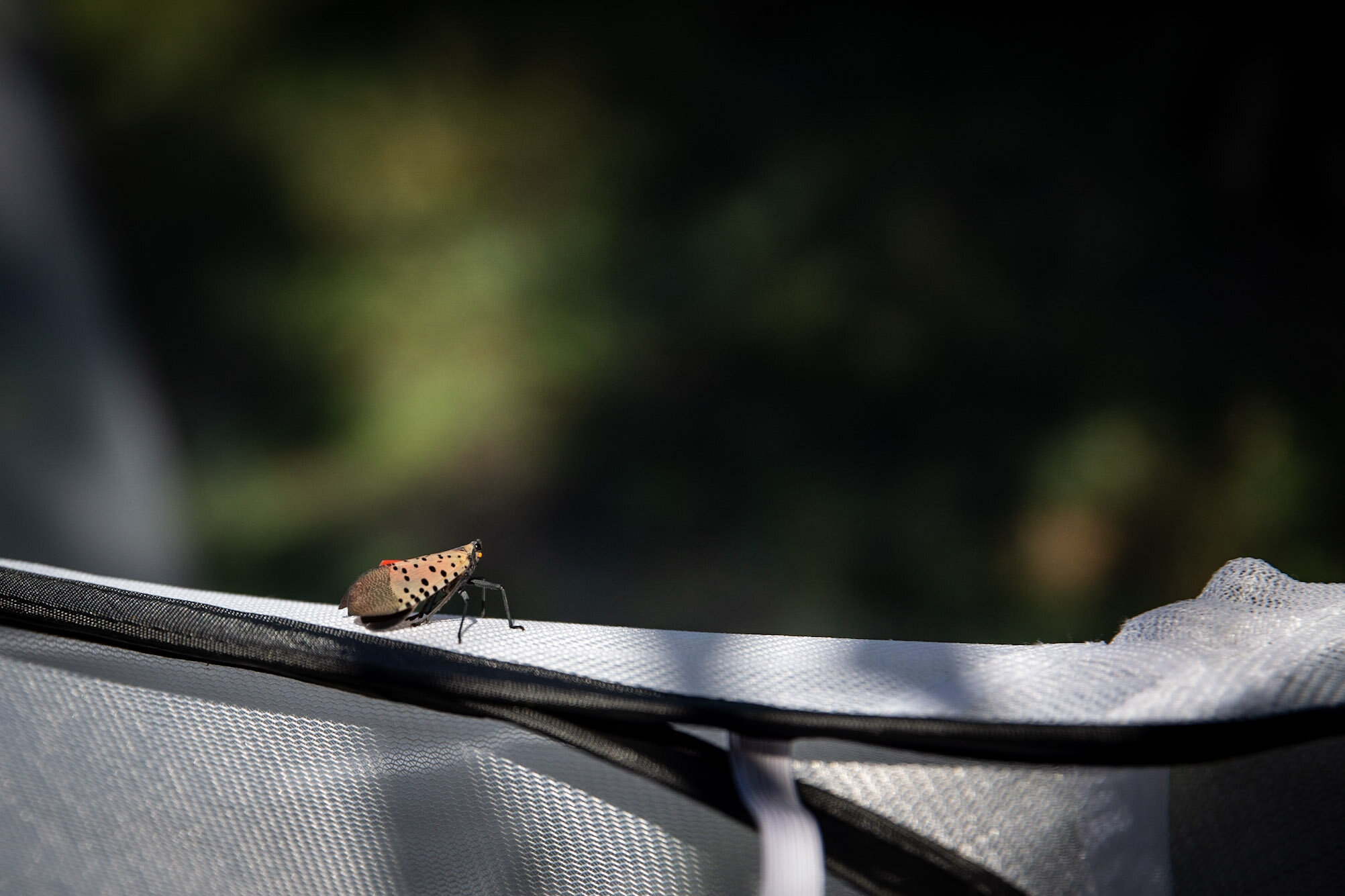
Alongside me were entomologist Osariyekemwen Uyi; Michelle Niedermeier, a coordinator with Penn State Extension’s Community Integrated Pest Management program (the agricultural outreach unit that is leading Pennsylvania’s lanternfly education effort); Robin Rick, facility manager at The Woodlands; and several other volunteers and Penn State graduate students.
The challenge was not finding or catching the bugs. They coated the bark of two trees of heaven we targeted, and crawled through the grass around us. They weren’t getting away either. Lanternflies are clumsy fliers, and, when spooked, tended to land a few feet away, often on fellow team members. They are also not very bright and it was easy to catch them by lowering open plastic bottles, so that they’d jump up into the mouths.
What made the task difficult was their fragility.
Uyi, who planned to study how the bugs affect the plants they feed on, needed them alive, and scooping them up by hand could kill them. We couldn’t catch more than 20 per bottle before emptying them into mesh holding cages, since at higher densities they could injure each other. Uyi and Rick clipped small tree branches and carefully shook them out into the holding cages.
The process took a while to adjust to. When I felt the soft thud of a lanternfly smacking into me, I had to suppress the reflex to swat it away. Instead, I’d reach toward it with a bottle and very carefully coax it in.
The first time i saw a spotted lanternfly, I saw a few hundred of them. It was September 2018, and I was stopping at the Allentown Service Plaza on I-476. Inch-long grey or tan insects, like moths with a high profile, seemed to be everywhere: flying clumsily in and out of bushes, landing on the pavement, and clinging to the building’s walls.
They’d first been spotted in the state about four years earlier.
On September 22, 2014, Daniel Lynch, a Wildlife Education Specialist with the Pennsylvania Game Commission had reported, “an unusual pest in large numbers on Ailanthus altissima [also known as the tree of heaven],” in Berks County. Pennsylvania Department of Agriculture (PDA) staff immediately responded, collecting more than 100 of the critters and sounding the alarm that a new pest had arrived. In fact, based on the numbers they were seeing and the presence of old, overwintered egg masses, it had already been here for two to three years.
The spotted lanternfly, native to China, India and Vietnam, is a large planthopper, smaller species of which might be familiar as skittish bugs that spring into the air when threatened. Planthoppers are “true bugs” (in the order Hemiptera), and like all true bugs they feed with mouthparts that form a long needle or straw through which they drink liquids. In large numbers, they can drink enough sap to weaken or kill their host plants. In addition to damaging plants by feeding, they excrete a sugary liquid called honeydew as a waste product, which can feed blooms of fungi that themselves can damage the host plants.
It does not help that the spotted lanternfly’s favorite host plant is the extremely common tree of heaven—an invasive East Asian species that thrives as a tenacious weed, quick to sprout and hard to kill. Neither does it help that our native bug-eaters avoid the lanternflies, which sequester toxins produced by the tree of heaven so that they themselves become distasteful. The bright red they flash on their hind wings also serves to warn birds away.
Agricultural officials knew to be worried when they identified the spotted lanternflies in Berks County. The bugs had spread into South Korea in 2004, attacking the country’s orchards and vineyards. It was not hard to recognize the threat they could pose to grape-growing operations in Pennsylvania, not to mention more significant wine-growing regions on the West Coast.
According to Heather Leach, an agricultural sciences associate at Penn State, recent population modeling found that trying to squash or trap our way out of the problem is futile.
The PDA tried to keep the spotted lanternfly contained by enacting a quarantine zone. That zone started off with a few townships in eastern Berks County, but lanternflies kept spreading. By the fall of 2017, the PDA had quarantined 13 entire counties, including Philadelphia.
As predicted, the lanternflies wreaked havoc on vineyards in their way.
Darvin Levengood, owner of Manatawny Creek Winery, in Berks County, says his winery saw its first couple adult lanternflies in 2016.
“Didn’t give much thought to it,” he recalls. “They started to hatch in 2017 and we weren’t too worried about the hatchlings and nymphs. We … found ourselves with a lot of adults, including the ones flying in from the forest.”
Grape production at their vineyards had dropped a little in 2017, but not enough to be worrying, Levengood says. The winery staff worked through the winter to scrape off every egg mass they could find, but in 2018 unusually wet weather and hordes of lanternflies, survivors from the vineyard enforced by adults from the surrounding woods, combined to devastate the grapevines.
“In 2018 the harvest was abysmal,” Levengood says, and in 2019 it was even worse as damaged vines continued to die.
I could still see the scars when I visited this July: gaps in the rows of grapevines where chardonnay, cabernet franc and other varietals had grown. Some rows were nearly empty, more weedy earth than vines.
By 2019, southeastern Pennsylvania had been infected with spotted lanternfly fever as much as it had been infested with the actual insects.
As the spotted lanternfly population exploded, the Philadelphia Police Department had to ask residents to stop calling 911 to report sightings. News stories and social media posts abounded, many of them depicting the bugs and instructing people on how to kill them. The effort to stop the lanternflies was often described in martial terms, with the bugs as invaders and humans fighting a war against them.
“Our desire to annihilate insects goes very deep,” says James McWilliams, history professor at Texas State University and author of “American Pests: The Losing War on Insects from Colonial Times to DDT.”
“There’s something psychologically terrifying about insect invasions,” McWilliams says. “I compare it to a virus—we know it’s around us, but we don’t necessarily know when and where and how it’s going to happen because we can’t see them at work.”
In terms of the spotted lanternfly, humans have tried to annihilate them every way possible.
YouTube videos depict locals seeking and destroying spotted lanternflies. Gardeners spray them with soapy solutions and attach sticky material to trees. Kids smash them with skateboards. A video of someone killing lanternflies with a propane torch has racked up more than 8,000 views.
However, according to Heather Leach, an agricultural sciences associate at Penn State, recent population modeling found that trying to squash or trap our way out of the problem is futile. These methods “have less than a 1 percent impact on their populations,” she says, careful to point out that traps might still hold promise for relieving feeding stress on individual trees.
You can stand in the vineyard and watch them come in, descending from the trees.” –Darvin Levengood Owner of Manatawny Creek Winery
“If you can reduce the population on trees you really care about and really want to protect, then you can make headway,” Leach says.
But local wildlife rehabilitators have been seeing unintended casualties with some tree traps.
“Right when the lanternfly problem emerged, we started getting the calls,” says Michele Wellard of Philadelphia Metro Wildlife Center. Spotted lanternflies aren’t the only animals that move up and down tree trunks, and many of the others, including birds such as woodpeckers and nuthatches, were getting stuck on the sticky lanternfly traps.
“Some come in really bad, with skin ripped off. We had a woodpecker with its tongue ripped out,” she says.
Oils are often used to make sticky traps less sticky, but an oiled bird is an emergency as much as a stuck one. The stress of being stuck, struggling and then being removed can also be lethal.
“Sometimes we get the bird and there’s nothing on it, and a day later it’s dead,” says Wellard, noting they have only been able to save one of every five birds.
Penn State Extension now recommends protecting larger animals from lanternfly traps. Options include wrapping chicken wire or hardware cloth around a sticky trap as a barrier or attaching the sticky material around spacers and facing inwards. In addition, a type of funnel trap developed to protect pecan trees from weevils can also be used against lanternflies.
The spotted lanternfly has kept moving despite all the trapping and squashing.
On March 15, 2019 the PDA expanded the quarantine zone west to include Dauphin County. In October 2019, researchers published maps showing where the lanternfly could spread, based on where the lanterfly now thrives. Prime habitat includes most of the Mid-Atlantic and Midwest. If the lanternfly can make it past the Great Plains and the Rocky Mountains, it could thrive in the major fruit- and wine-growing regions of California and the Pacific Northwest.
In july 2020, Niedermeier and Uyi invited me along to The Woodlands to scout for the collecting trip in August. Spotted lanternflies hatch out as white-spotted black “nymphs” in the spring. These are roughly the same shape as adults but without wings. As they grow, they shed their exoskeleton five times, with each stage called an “instar.” The fourth instar has a mostly red-background, and it sheds into the winged adult form in late summer. In the fall the adult females lay eggs in masses that look like smears of concrete.
Though we certainly saw plenty of lanternfly nymphs in low vegetation, like the milkweed in The Woodlands’ meadow, the real hordes of them were up in the trees, particularly the trees of heaven and paper mulberries. Smaller branches were almost encrusted with nymphs, so Uyi concluded he would have no problem finding enough for his study.
Rick, a Woodlands’ manager, showed us around on the scouting trip. She had spotted her first lanternflies at The Woodlands in the fall of 2018, near the railroad tracks that run along the eastern edge of the cemetery.
In 2019, they were “distributed across the site, but not in large numbers,” she recalls. In 2020, “they took over the whole property.” Last year, The Woodlands participated in a USDA program that involved killing smaller trees of heaven but leaving larger ones, treated with an insecticide, as lethal traps. “We did see a drop in numbers after that treatment, but then in September, when the adults really started to move, the numbers shot back up again,” says Rick.
Leach confirmed this pattern.
For example, you can scrape off egg masses, but “what you’re able to scrape is less than 10 percent of what’s in the tree,” Leach says. Lanternflies are incredibly mobile as well. The nymphs can cover roughly 50 yards in 24 hours, she says. The winged adults can cover more distance in the air.
“We’ve definitely observed them riding thermals [warm rising air], so you can see them considerably high in the sky,” Leach says. “They’re capable of longer dispersal than we really thought. If not high up, then they’re doing these constant short bounces of 20 to 25 feet. They do it over and over again.”
Still, there may be hope of controlling the invasive pests—though native birds and insects don’t have much of a taste for lanternflies, some of our fungi just might.
On October 9, 2018, next to an apple orchard near Reading, Pennsylvania, large numbers of spotted lanternflies died with what looked like cotton growing out of them. The cotton was the spore-releasing structure of two species of native, insect-eating fungi. One, Beauveria bassiana, is already commercially available as a biological control agent for other insect pests, meaning it will be easy to apply to spotted lanternflies.
Researchers from Penn State and Cornell followed up in 2019 and found that the commercially available fungal agent does indeed kill lots of lanternflies. This year they are testing different application methods to refine the practice and compare its effectiveness to that of commonly used chemical insecticides.
USDA researchers are also vetting two species of tiny wasps that, back in China, lay their eggs on lanternfly nymphs and eggs—the wasp larvae then feeds, devouring the lanternflies from within. It will take several years to confirm that these lanternfly killers will control lanternflies here and, just as importantly, leave native insects alone.
While we wait on biological control options, Pennsylvania’s strategy to slow the spread of spotted lanternflies targets human-assisted transportation. Although the lanternfly can certainly disperse on its own, we inadvertently help it cover more ground.
For example, it most likely reached the Pittsburgh area via rail lines, according to Shannon Powers, press secretary for the PDA.
“It doesn’t fly that far, but it’s a wonderful hitchhiker,” she says.
The quarantine zone targets the hitchhikers. Businesses have to apply for a permit to move agricultural products and other goods across the quarantine perimeter. Anyone transporting objects (industrial equipment, cars, hiking gear) that could potentially carry a lanternfly or an egg mass from inside the quarantine zone to outside the zone is required to search for all lanternfly life stages and carry a filled-out inspection checklist with them.
The PDA is also trying to get rid of the lanternfly’s favorite tree at either end of potential routes out of the quarantine zone.
Powers notes that it is impossible to cut down every tree of heaven in Pennsylvania, but “we have been targeting places where there is a tremendous risk of spreading the insect, like shipping yards, railways, and tourist destinations, particularly ones surrounded by wooded areas or agricultural fields,” she says, explaining that this includes state parks where campers from inside the zone might vacation.
Although the department is still interested in spotted lanternfly reports from inside the quarantine zone, it particularly relies on reports from outside the zone to figure out where new populations might be gaining a foothold and then to control those before they spread.
“We have sent teams out responding to every report outside the quarantined area,” says Powers.
This spring the PDA expanded the quarantine zone in a continuous area stretching from the Delaware River to Blair County in the west, and then, after a gap of several counties, Allegheny and Beaver in southwestern Pennsylvania. Much of western New Jersey is now lanternfly territory, as is northern Delaware, northeastern Maryland and a small portion of northern Virginia and adjacent West Virginia. Isolated lanternflies have been spotted as far south as Western North Carolina and as far north as the Boston area and Upstate New York.
As a rising tide of spotted lanternflies were flooding Philadelphia, their numbers were declining in Berks County, where they were first encountered. If you think of the infestation as a wave rolling out from Berks County, Philadelphia is experiencing the crest, while areas just to the northwest are heading into the trough.
“We’re still learning a lot, but basically we saw a reduction in that ground-zero area,” says Leach. “There were fewer last year, and they weren’t laying as many egg masses.”
No one is certain why. Leach speculates that the lanternflies’ favorite host plants had been stressed in the peak years to the point that they were less attractive, and lanternflies moved on. The decline also could have had something to do with a wet autumn in 2018, hindering egg-laying. Leach was also careful to note that the decline might be temporary.
“We are seeing an increase in populations this year where there was a decrease last year. It’s not that crazy high population that we saw, but we are seeing a resurgence. Kind of an ebb and flow,” she says.
Levengood observed fewer in 2019 than in 2018 but speculated that the population decrease had more to do with the weather than anything else. His operation has adapted as well, spraying insecticides to kill nymphs through the summer.
“From the time I do that spraying till the time the adults come in, our vineyards are
lanternfly free,” he says, though they can’t stop adults from flying in from surrounding areas. “You can stand in the vineyard and watch them come in, descending from the trees.”
Uyi’s project is one of many attempting to understand how spotted lanternflies will impact North America and what we might do to mitigate the damage.
There are 900,000 known species of insects in the world, and we know very little about the vast majority of them unless they start causing us problems.
Leach pointed out that we have only been studying spotted lanternflies for six years in North America.
“We still don’t have an effective way to measure a population in an area,” she says. Traps on trees tell researchers where they are and can convey a crude sense for how dense their populations are at particular locations, but they don’t have any way to tell how many are across the state or city.
It isn’t certain whether or not we will be able to curb the spread of spotted lanternflies. Similar to other invasive species, like the emerald ash borer, it could turn out to be unstoppable. Dead ash trees now stand out in our forests and roadsides, conspicuously naked in summer amid the dense green of the surrounding trees. In a few years, the only ash trees left will be the ones we can afford to treat with insecticides.
Or, similar to the Japanese beetle that arrived in 1916 at a New Jersey plant nursery across the river from Northeast Philadelphia, they could hit like a tsunami and then fade into the background as critters that we learn to manage.
At Manatawny Creek Winery, I stopped to look at shiny green Japanese beetles and the grape leaves they had skeletonized, leaving a lace-like structure of leaf veins with nothing in between. Levengood says that they spray insecticides three times a year to control the Japanese beetles, but some still survive.
Still, for six years we have managed to at least slow spotted lanternflies’ spread, buying time for researchers to learn more about how we can control them.
Powers points out that South Korea is about the same size as Pennsylvania, and there, “they spread throughout the country in three years, so we feel like our efforts have been successful,” she says.
Uyi’s team spent about four hours at The Woodlands catching spotted lanternflies, but I had to take off a little early. As I prepared to leave the August collection at The Woodlands, I found one last spotted lanternfly on my shirt. I tried to shoo it off gently, and it crawled on my finger, where I let it sit for a moment. I couldn’t help but admit that it was a handsome critter, fawn-colored wings with black spots and a delicate net pattern toward the back.
It jumped away, and I let it go.

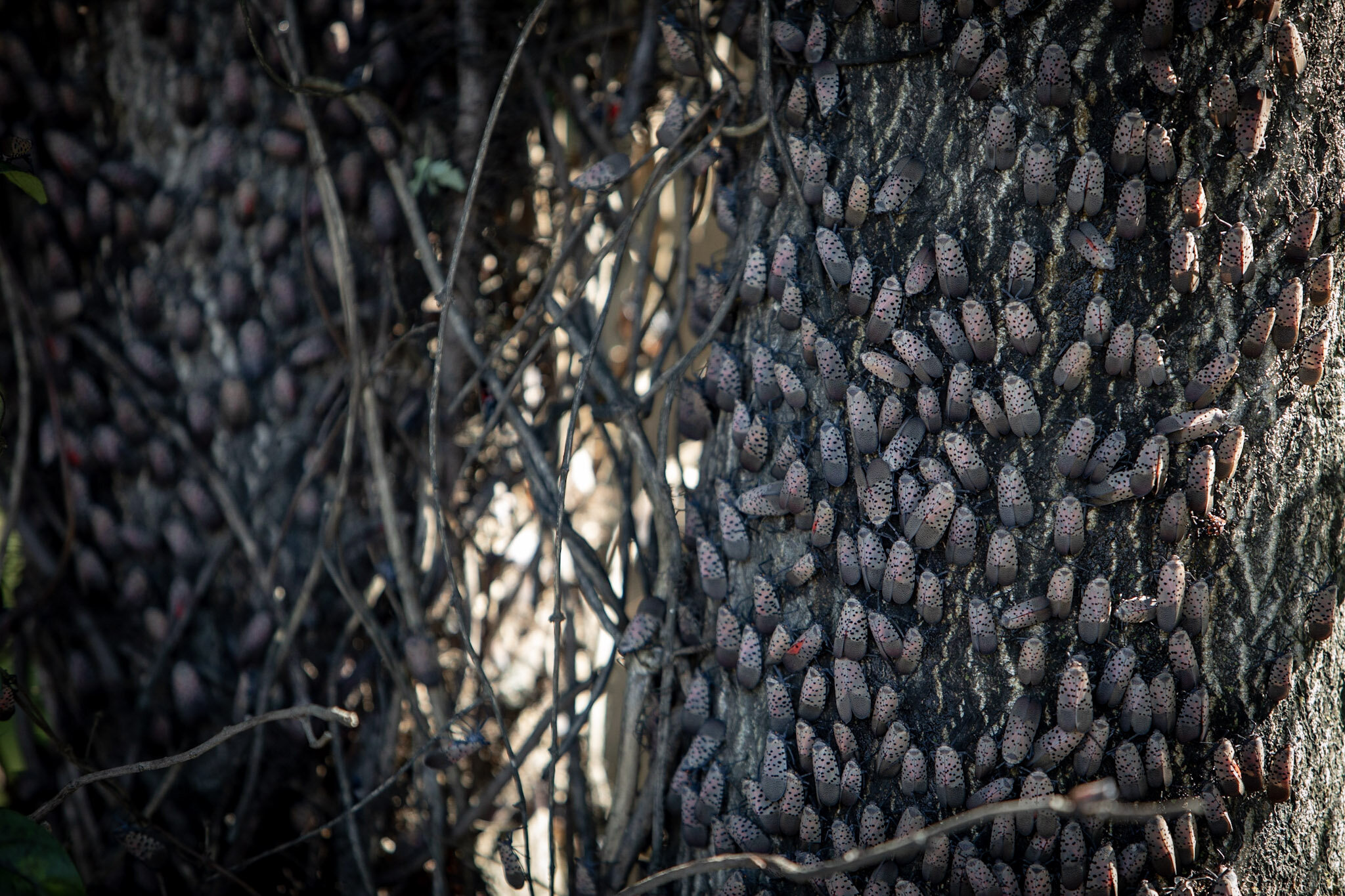
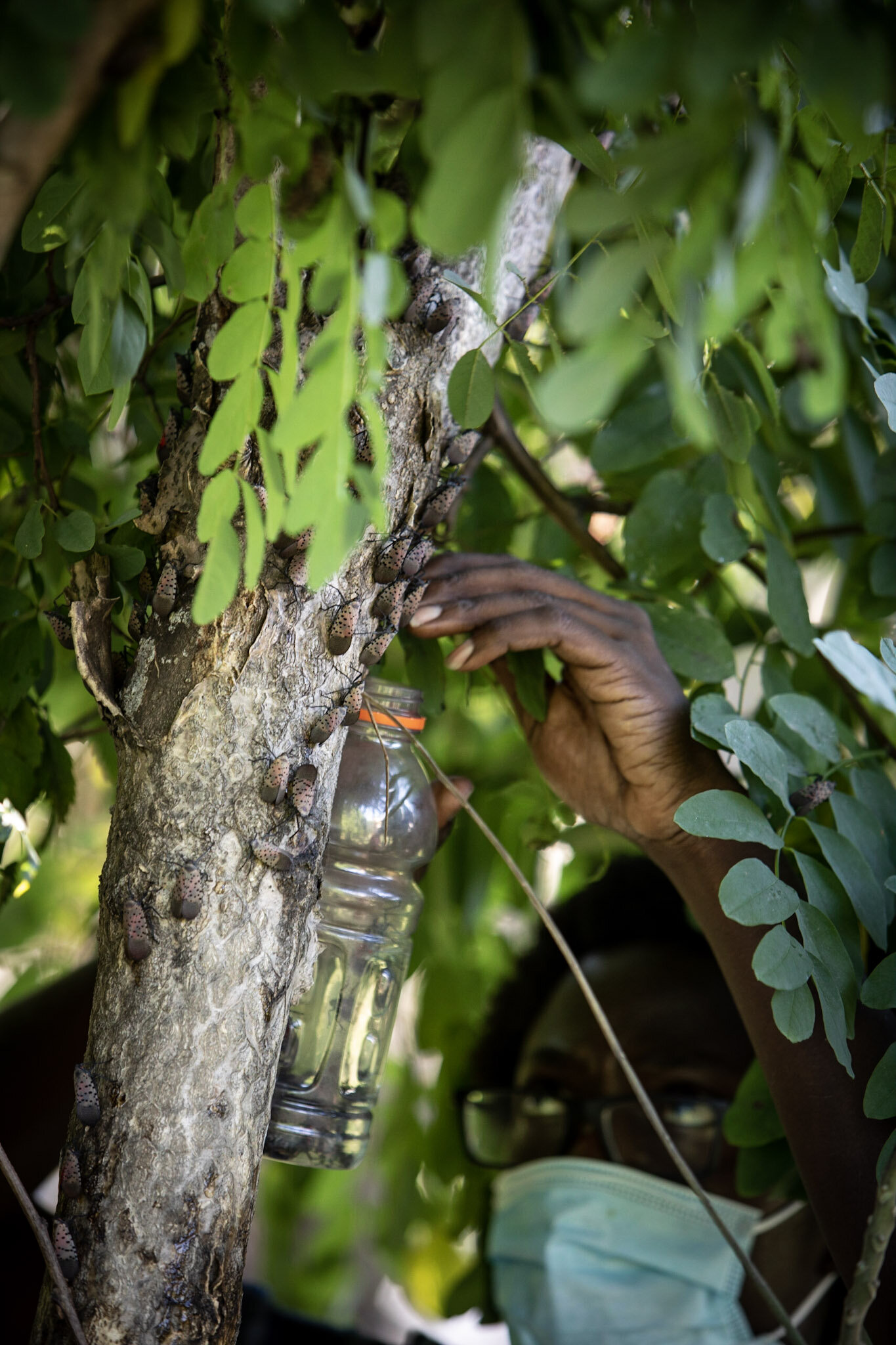
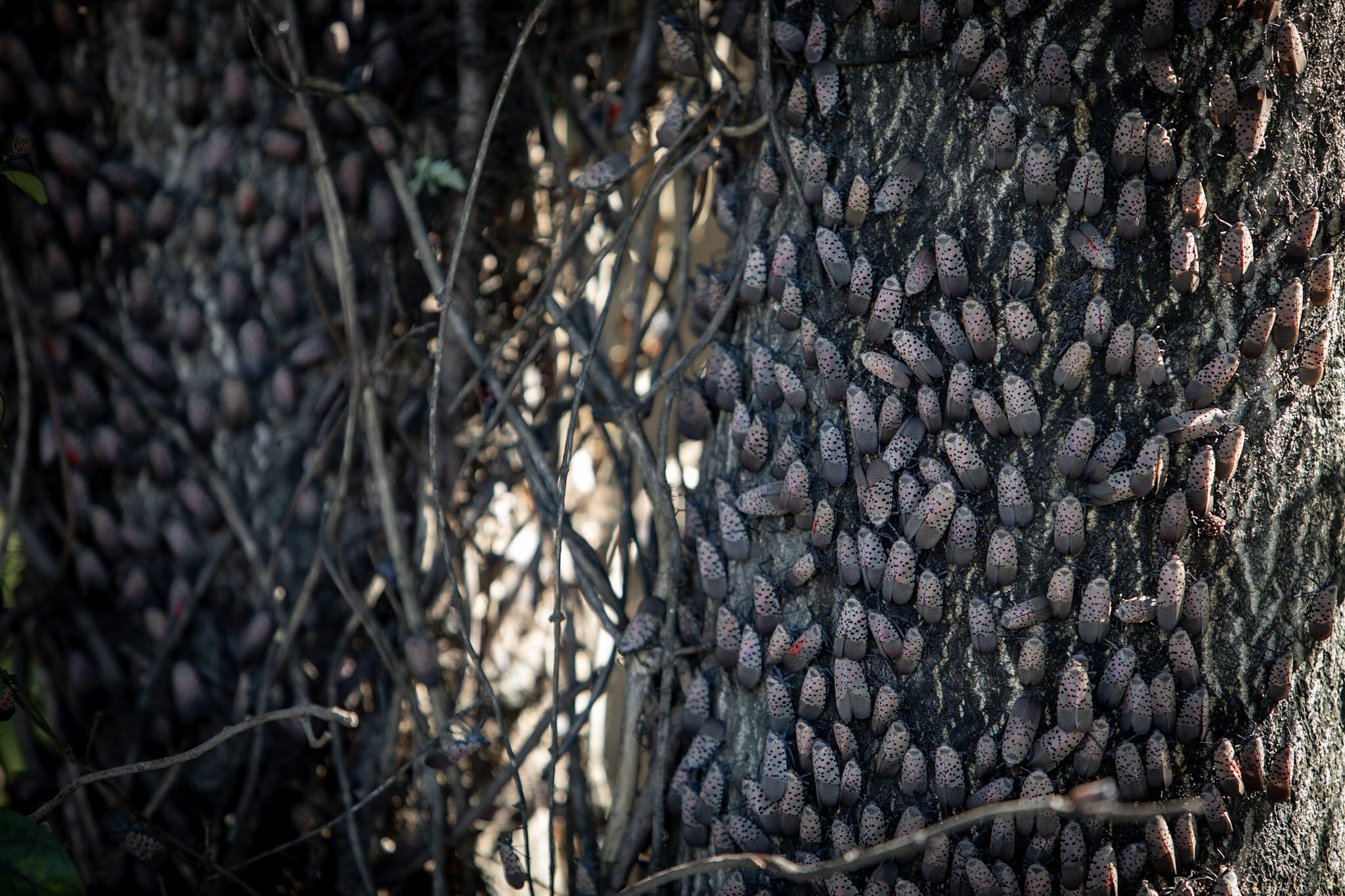
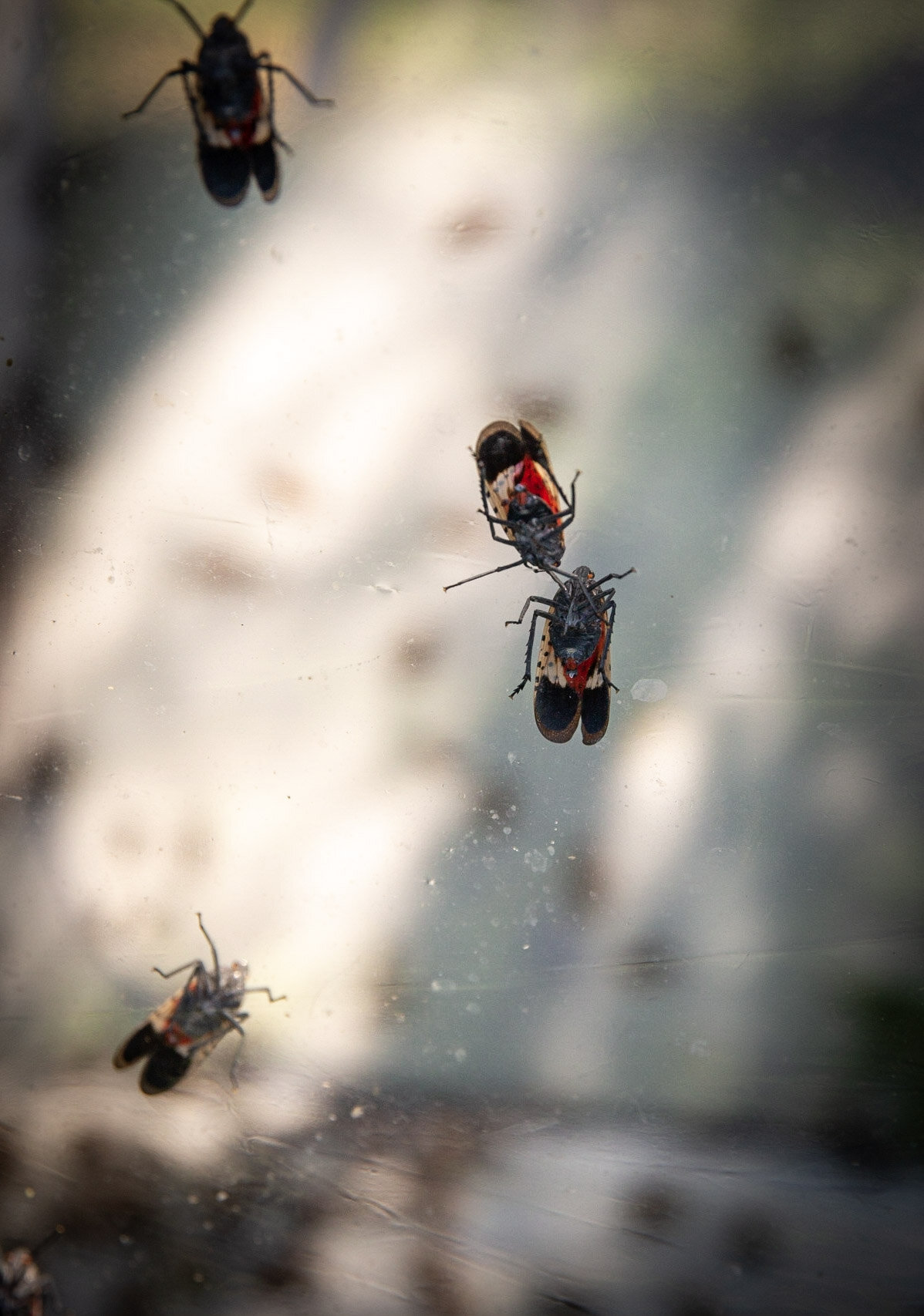
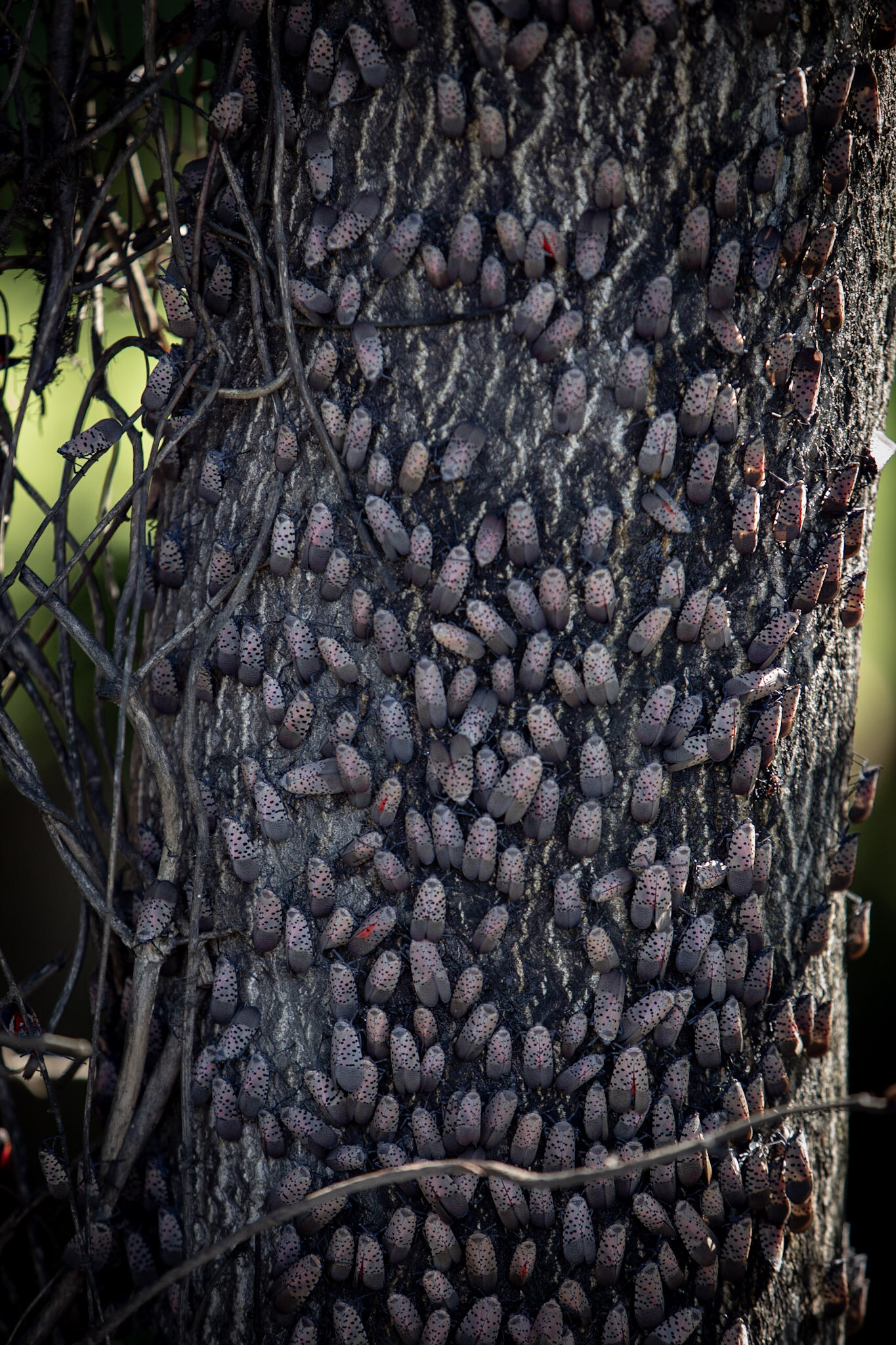

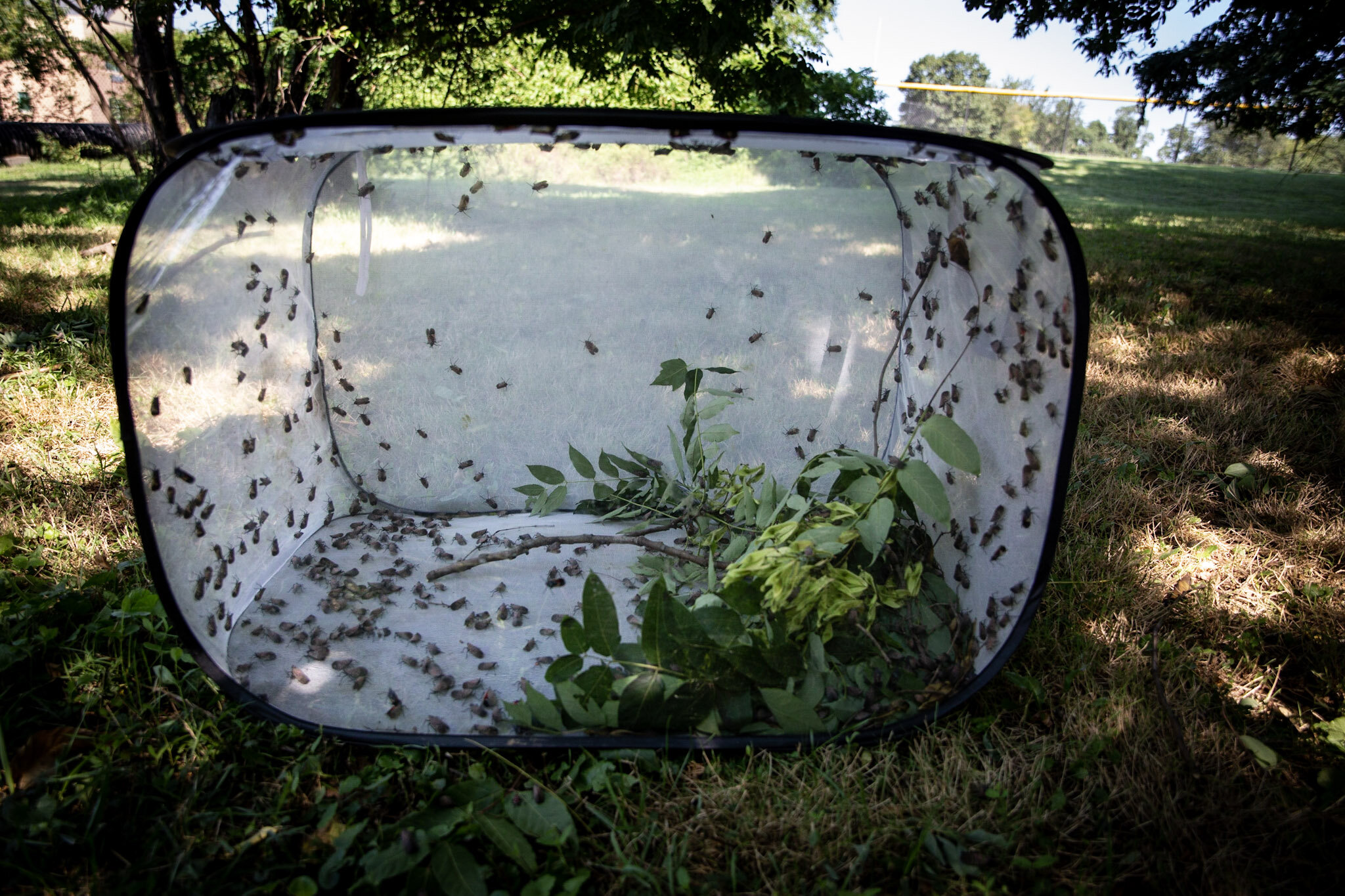

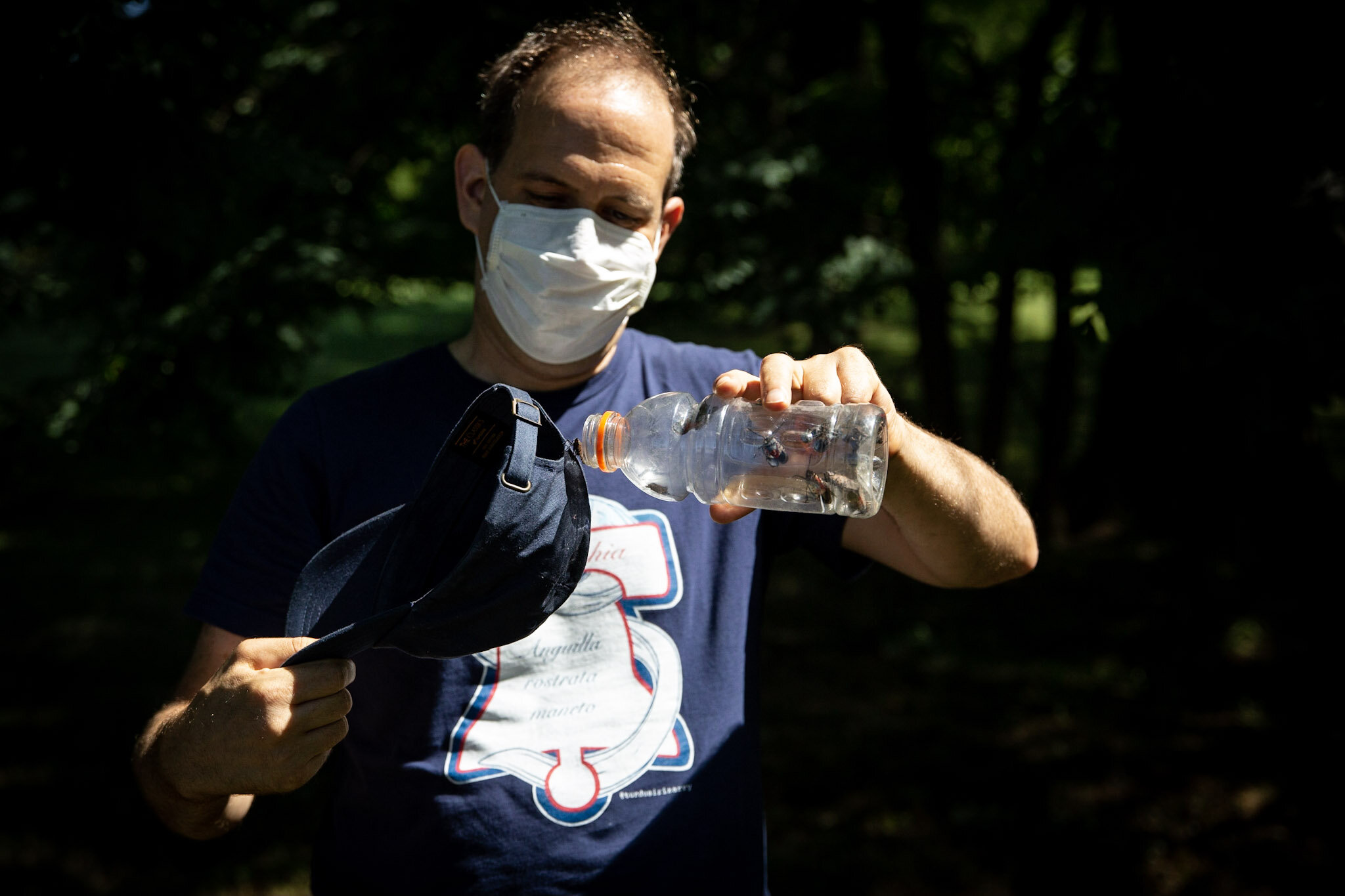





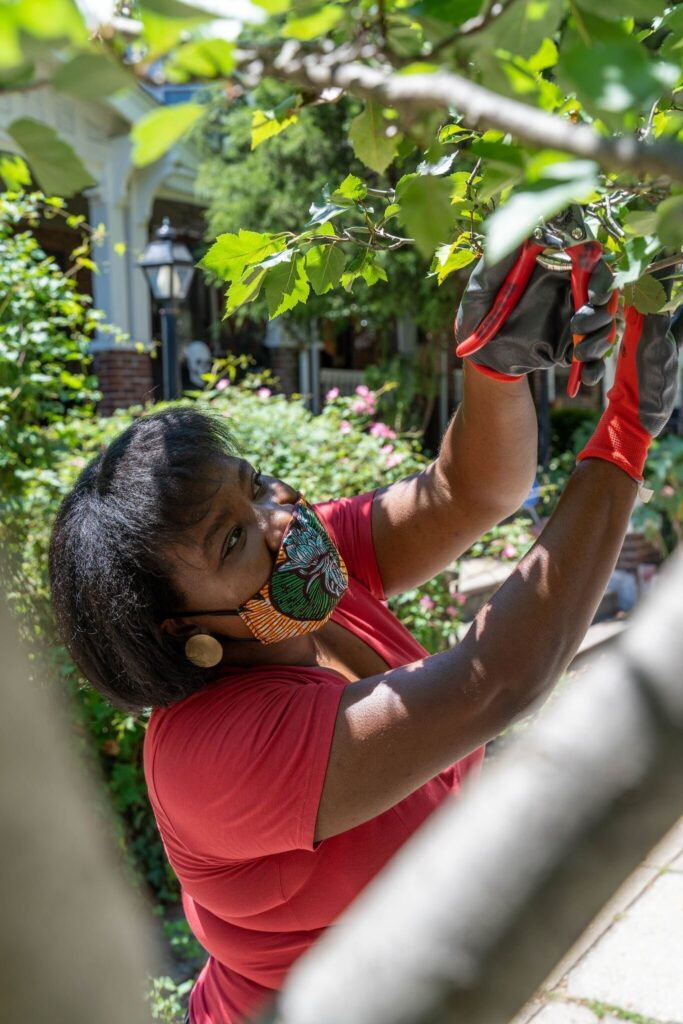

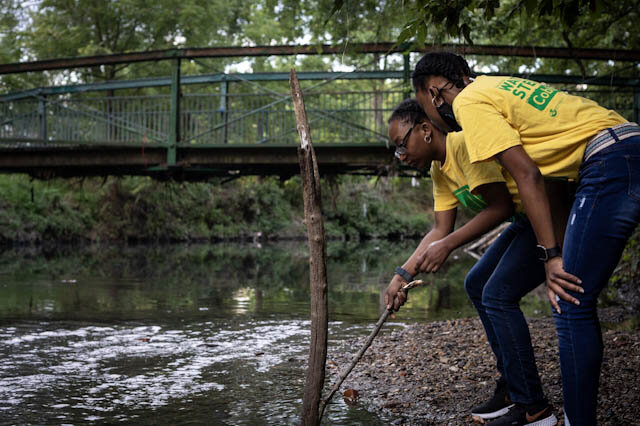
2020 was the first year that I spotted them in my backyard in West Philly. Honestly, I never heard or noticed them until this year… They freaked me out through the various morphing stages. I try and swat them with my broom and they usually jump or fly toward me… I find this behavior very strange as most insects generally fly away from potential threats. Anyhow, today was the first time I noticed a tiny spider caught a full grown lanternfly and was paralyzed caught up in its web.. Maybe they can be useful to managing the population? Anyway, thanks for the article.